Eurasia Today: Chinese Bicycles, German Cars and Provincial Hungarian Communities
Author: Chris Hann
September 18, 2017
Introduction: the way things used to be
For my doctoral research I lived for 10 months in 1976-77 in the village of Tázlár in the county of Bács-Kiskun, south-central Hungary. My project was focused on continuities in smallholder farming but I could not help noting that many villagers had jobs outside agriculture. I lived on the main street next to the bus stop, from which commuters departed on every working day to the factories of the nearby market town, where the shift started at 6.00am. One factory was particularly prominent in village conversation: “the metalworkers”.
This commuting was far too early in the morning for me to investigate in detail; but I observed that, when they returned to the village in the afternoon, some of these wage-workers devoted themselves to productive activities in their gardens and fields. The phenomenon of the peasant-worker was ubiquitous in socialist Hungary. The relative success of collectivization owed much to the symbiosis of the labour-intensive activities of household members with the capital-intensive economies of scale attained in socialist cooperatives and state farms (Hann 1980, Swain 1985).
But this success was not achieved without costs. It was often suggested that workers refrained from a full commitment to their factory jobs in order to save their energies for private activities, where economic incentives were more effective. Full employment was a basic condition of the planned economy. It was maintained through a mechanism based on the calculation of an average wage. Managers had incentives to hire more cheap labour than they really needed, in order to have the possibility of paying higher wages to those on whom the enterprise really depended for its economic viability. This was the main reason why low-skilled factory jobs were readily available to Tázlár villagers (and also to local urban Roma).
In those days, all Tázlár children proceeded to some form of further education or vocational training when they graduated from the village school at the age of 14. After that (simplifying a little, and ignoring considerations such as male conscription), whether or not they completed their courses and obtained qualifications, four or five career options were available. The first was to carry on living at home and work full-time on the family farm. This option was possible because Tázlár had been spared the standard form of collectivization (for ecological and economic reasons, the continuities with traditional forms of smallholding were greater in the county of Bács-Kiskun than elsewhere in the country). But few villagers followed this path (which was frowned upon ideologically by contemporary power holders). Most preferred to have a source of secure wage-labour income. It was easy to find such jobs, either in the local specialist cooperative or state farm, or by commuting to an urban factory such as "the metalworkers". These were career options two and three. A fourth option was to migrate further afield. Some Tázlár youth, in line with their qualifications, gravitated towards Budapest, only 120 kms to the north, or to other towns where industry was expanding. But permanent migration was not easy due to the shortage of housing, and in any case urban residence carried the disadvantage that it hindered the pursuit of supplementary accumulation strategies through small-scale farming.
The way things are nowadays: for example, Chinese bicycles
My 1970s project concerned the land and I would have raised eyebrows had I sought permission to accompany villagers into their factory workplaces. It is far too late to remedy this deficiency but recently I have started a new project in this nearby town and talked to some of those old enough to recall the creation of its socialist industry, as well as transformations after 1990. The mythical factory of “the metalworkers” that provided industrial jobs to inhabitants of Tázlár in the 1970s ran into trouble in the 1980s and was swallowed up by larger state enterprises. As elsewhere in Hungary, the factories of this town were plundered in the early 1990s. No one questioned the quality of their products and the abilities of well-educated engineers and skilled workers; but COMECON markets collapsed and there was no possibility of a speedy breakthrough in the West. Bankruptcy and privatization ensued. The most common pattern involved cherry-picking by senior managers, who no longer had any incentive to maintain the disguised unemployment of the socialist decades. Unemployment rose rapidly in the 1990s.
Even before the end of socialism, some factories were being sold off to foreign corporations. Levi-Strauss made a major investment in 1988 and employed over 500 workers before deciding to relocate its activities to Romania in 2009. The local authorities have attempted to attract new multinational concerns to largely derelict industrial estates, but without success.i The site known simply as “Levis” was bought by a local businessmen, who uses part of it for his bicycle business and rents out the rest to a variety of other local firms.
The bicycles are not manufactured here. The various parts all derive from China (even if 40% are officially attributed to other European countries). Little skill is involved in assembling them. Until recently the work was carried out by the 80-strong labour force on a piece-rate basis, so that wages reflected the individual worker’s productivity. Now the firm is attempting to introduce a belt system, increasing specialization and automation. This has not proved popular, not only due to alienation from the labour process but because this automation has been accompanied by a decline in net income for many employees (and, on occasion, to excessive hours that are not compensated through payment of overtime rates). Conditions in this factory are generally considered bad. One of the demeaning details I heard was the fact that, to prevent pilfering, workers are required to bring in their own tools.
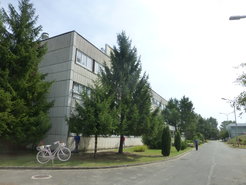
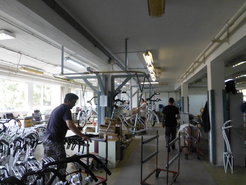
On the other hand, conditions in most of the other small and medium-sized firms that have replaced the vast socialist enterprises are little better. Employers declare almost all of their workers at the minimal wage, in order to minimise their employers’ contributions. In reality, the bosses find various ruses to pay out more than the prescribed minimum, especially to those workers they do not wish to lose. Precise knowledge of these supplementary payments is not public. They will not be reflected in the worker’s eventual pension. It is not surprising that the owner-managers of these firms are widely viewed as sharks, interested solely in maximizing their profits. Exceptions are made for those who won respect for salvaging as many jobs as possible in the 1990s, and who pay wages above the average today. But such respected individuals have mostly retired by now, or initiated at least a partial transition of responsibility to the next generation. The children who have inherited the business are more likely to have studied marketing or HR than engineering.
In spite of much rhetoric from politicians of various parties, these remuneration practices have not changed significantly throughout the postsocialist period. While some accuse the “new capitalists” of ruthless profit-maximization, others defend them by pointing out that these firms would not survive if they had to pay higher wages. What else can the new elite be expected to do? Meanwhile the technical intelligentsia of the socialist era tend to liken today’s arrangements to a new form of slavery, in which Hungarian workers are deskilled and exploited to serve the interests of capital accumulation elsewhere.
Mercedes: made in Kecskemét
The problem of pilfering is addressed in a very different way at the new Mercedes-Benz factory which dominates the skyline on the outskirts of Kecskemét, the county capital of Bács-Kiskun. Here everyone must go through security controls at the entrance. This applies also to the members of organized visitor groups, who must hand over their cameras before being allowed to observe the highly automated production line of almost one kilometre that yields a sleek new Mercedes every two minutes. Although the planning began under the previous government, this huge investment was formally opened in 2012 under the Fidesz government led by Viktor Orbán. It currently employs over 4000; and since many components are produced by local factories, the total economic impact of the factory on the region is much greater. At all levels, the authorities continue to be supportive in every possible way, such that a massive extension is scheduled to become operational in 2020, creating a further 3000 jobs in the main plant alone. For a provincial city in which the largest industrial employers previously were in the food sector (canning and alcoholic beverages), this investment by a famous transnational corporation is a trailblazer. It is the opposite of the pattern in all other towns of the county, where large socialist enterprises have ceded place to smaller, private or family-owned units.
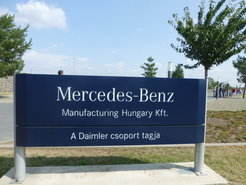

Of course, the anthropologist’s job is to dig deeper and to enquire not only into economic causes and effects but into social dimensions of the “Merci” phenomenon. I was interested in doing so because, although Kecskemét is over 40 kilometres from Tázlár, a number of young men undertake this long commute on a daily basis.ii The road is poor, especially in the winter. Yet there are some attractions. Wages are significantly above the prescribed national minimum, approximating 500 Euros monthly for a line-worker. They are supplemented not by more or less illicit transfers in the grey sector but by formally negotiated perks (such as an excellent canteen) as well as informal privileges for certain categories of staff (such as the possibility to test-drive new vehicles).
Yet I was told that many unskilled workers do not stay long. The workforce, as I observed it in August 2017, is overwhelmingly young – perhaps early twenties on average.iii I was told that, for the great majority of jobs, no qualifications are necessary beyond the completion of elementary school. Since so much of the assembly work is undertaken by robots, the main task of the worker is to remain constantly alert in the execution of physically undemanding and generally clean tasks as the vehicles move along the belt. Slogans proclaim that every car which rolls off the line is unique. This is counter-intuitive to the visitor, but such branding at the top end of the market where this firm operates is important. In addition to colour and certain structural variations (such as right-hand drive for the UK and Ireland), customers can order individualized upholstery. The production of automobiles has come a long way since the pioneering standardized models of Henry Ford (not to mention the pin factory of Adam Smith). The philosophy of Mercedes-Benz highlights constant innovation. Yet it is clear that little if any of the new technology used in Kecskemét stems from local ingenuity: it is telling that the engines are imported from Germany.
Disassembling Hungarian communities
So far in this post I have described how German cars and Chinese bicycles can be profitably assembled in postsocialist provincial Hungary, where the old industrial base has largely disintegrated. Clearly this is a story of globalization, not limited to flows across Eurasia. Many of the cars made in Kecskemét are fitted with the distinctive lighting features required for the North American market (very few are sold locally, because despite discounts for employees, they are still far too expensive for the great majority of Hungarians). What are the consequences of these new configurations of capital and labour? How do the options available to provincial Hungarian youth today compare with the options available to their parents and grandparents in the socialist decades?
Some of the answers to the last question have been given in the previous sections. Villagers and urban residents alike can seek local wage-labour jobs, either in the small-business sector with local Hungarian bosses, or with transnational corporations. Mercedes-Benz is a one-off, but supermarket giants and smaller chain stores (such as the German D&M and Rossman) are managed by Hungarian staff and pay higher wages than local businesses (at least nominally). But even here it is rare for a worker to take home more than 450 Euros a month.
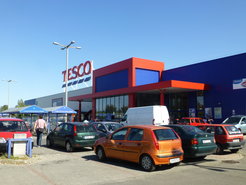
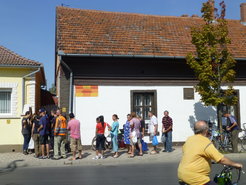
One contrast with the socialist era is the great reduction in opportunities for small-scale commodity production in agriculture. The days when cooperatives assisted their members to keep cows and raise hogs in their backyards have gone for good. Small-scale vineyards are similarly unviable. Following the privatization of the early 1990s, farming has become a highly capitalized profession that increasingly approximates the norms of Western European agribusiness. It is not a sector that young people can enter from scratch. The majority of those who work on the land are not owners but constitute a new rural proletariat. It is most conspicuous in the late summer when labour is needed not only to pick grapes (though much of this harvest is now mechanized) but also other labour-intensive crops such as paprika or elderberries.
The dearth of labour market opportunities has been addressed by the state in various ways. Workfare schemes have been massively extended by Fidesz-led governments (though they were first mooted by socialist politicians before 2010). Unemployment benefit has been drastically reduced and other benefits eliminated, such that hundreds of thousands of Hungarians have been left with no alternative but to apply for workfare. Most of them are paid about 175 Euros monthly. In the early years of the scheme, many young people quit vocational training courses in order to sign up for workfare when they turned 16 (later the minimum age was raised to 18).
Some participants welcome the schemes because, in spite of the very low wages, these jobs carry social security and pension entitlements, and they are undertaken in less exploitative conditions than any available alternatives, in factory or field. Not everyone approves. Some middle class citizens bemoan the fact that workfare recipients are set to work for the most part in public works such as park maintenance, where labour discipline is very obviously lacking and no value is created. Others complain that the schemes serve only to enable the government to claim successes in lowering the unemployment statistics. There is little evidence that workfare programmes do much to prepare participants for joining the regular labour market, their ostensible goal. The Roma, conspicuous in socialist days as the “disguised unemployed” in socialist factories, are now conspicuous as long-term workfare participants. Other critics allege that, when workfare is used to produce commodities for sale, it necessarily leads to a further distortion of markets. Still others have pointed to the ways in which these schemes strengthen the power of local officials and the political party to which they belong.iv Nevertheless, in spite of all these problems, most inhabitants of Bács-Kiskun endorse the view that making participation in the labour force a prerequisite for family survival is preferable to simply doling out benefits. A common way to illustrate this point is to assert the long-term beneficial impact on children (including Roma children) who see that their parents get up early and lead disciplined lives (the working day normally begins at 6.00am).
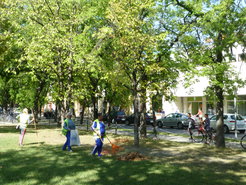
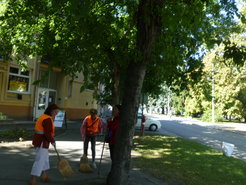
The state has been a major actor in other recent developments on the labour market in the county of Bács-Kiskun, which has a long border with Serbia and has been at the centre of the “migrants’ crisis” that has featured prominently in Hungarian and European politics since the summer of 2015. I have yet to meet anyone in Tázlár who has set eyes on a Syrian refugee, or any other foreigner seeking passage to Germany along the “Balkan route”. But such migrants have been spotted in Tesco in the nearby town, where thousands were billeted in an old barracks in the months when Viktor Orbán took a tough stance and, insisting that he was defending European civilization and acting in accordance with international agreements, eventually constructed a new fence to seal the border. Large-scale investments to improve the accommodation at the barracks generated many jobs for local residents. But by mid-2017 it was clear that Orbán's fence was doing its job and this facility was superfluous to requirements. The government has prolonged the state of emergency, but the sole remaining spinoff for the local economy is the continuing need for border policemen. The qualifications required are low but these openings are not considered very attractive; the shifts are long and the work potentially unpleasant, even if the wages are significantly above those paid in local factories.

Given the drawbacks of all these various options, it is unsurprising that large numbers of young Hungarians have decided to become migrants themselves. There are no precise data for numbers and destinations, but one often hears the claim that, after Budapest, London is now the second largest Hungarian metropolis on the planet. One hears too of how families are torn apart by these migrations, of how youngsters with university degrees fetch up making beds and washing dishes in hotels, of how provincial Hungarians provide care for the wealthy in the West while their own close kin may be desperately in need of care at home.
Of course, some emigrants do manage to secure employment matching their qualifications. Some manage to save money and return after a few years to build a house and launch a new career in their homeland. But there is general agreement in Bács-Kiskun that these positive cases are exceptional. The transfer of regular remittances is rare. Some parents point out that, although their children might seem to be earning rather a lot, the exorbitant cost of living in a city such as London leaves them no better off; sometimes it is the parents who must transfer money to Britain from their modest pensions in order to bring the family together at Christmas. If emigrants marry and have children abroad, it is even less likely that they will return permanently. Most people consider that standards in Hungarian education have declined considerably since socialist days; what is the point in raising a family in a country where skills have been devalued and prospective income streams are so low?
Conclusion: political and academic implications
These labour market conditions are the subject of intense political debate. The government claims it is doing everything possible to support small and medium-sized Hungarian businesses in creating new jobs. It continues to support investments by transnational corporations, while exhorting the likes of Mercedes-Benz to transfer some research and development activities to Hungary, rather than just the low-skilled assembly line jobs. Meanwhile opposition parties support those who protest current conditions, such as the Tesco workers who went on strike in summer 2017. They argue that the large-scale emigration of Hungarians is driven by the impossibility of surviving on domestic wages, and that saturation coverage of the international migrants’ crisis on government-controlled media is mere diversion from the urgent need to address problems of inequality and corruption at home. Government spokesmen respond that many young people migrate in a spirit of adventure (kalandvágy) and that a raft of new measures is already helping to ensure that most, especially those whose contributions are most needed, are being re-integrated into the Hungarian labour force.
Again and again in interviews and informal conversations, my interlocutors kept coming back to the unfairness of domestic wages, pointing out that a great many commodities (from petrol to many basic grocery items) nowadays cost as much in Hungary as in the wealthy countries of the “old EU”. The left-leaning opposition is in disarray, partly due to the fact that the socialist-led governments of 2002-2010 are still held by many voters to bear most of the responsibility for the parlous conditions that prevail today. Under these circumstances it is unsurprising that a campaign for “wage-union” (bérunió) has been launched not from the left but by the right-wing populists of the Jobbik party. “The same pay for the same work” is a principle that sounds intuitively convincing when Hungarians compare the remuneration on offer in Kecskemét with that which Mercedes-Benz pays in Stuttgart.
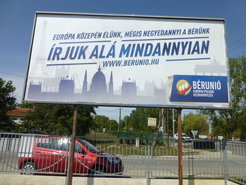
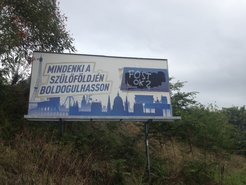
But then, others are quick to point out, why would the Germans have invested in faraway Hungary in the first place if the location did not guarantee significantly lower costs? In the small-business sector, owners sometimes justify paying lower wages by stressing that equal pay is only warranted when equal value is produced. Their workshops tend to be less automated and labour discipline less intense than at Mercedes-Benz. Under these conditions, lower wages are essential if they are to remain profitable in niche markets and maintain employment levels. In short, bérunió is derided by most employers (even those who might otherwise harbor sympathy with the nationalist agenda of Jobbik) as a populist illusion. Besides, on what basis should wage uniformity be confined to the EU? It is obvious to all that the bicycle assembly plant described above owes its existence to the payment of extremely low wages to those who produce the components in China.
The economic and ethical dimensions of these configurations pose everyday challenges to various categories of actor in Hungary, but also to anthropologists. There is an overwhelming consensus in provincial Bács-Kiskun that Viktor Orbán was right to build the fence, that national frontiers need to be defended, that identities as well as economies need nurturing and protecting. Surveys suggest that these attitudes are common throughout Europe, and reach their highest levels in the Visegrád states. Yet most academic analyses of the migrants’ crisis that I have seen, whether by Hungarian social scientists or foreigners, show no empathy with these attitudes; they tend to be highly critical if not downright contemptuous of the policies of the government in Budapest.v
Johann Gottfried Herder, widely viewed as a founding father of socio-cultural anthropology, was forthright in his condemnation of all forms of slavery. He believed with passion that human beings could only be happy in their native land and Klimate (Gossiaux 2016: 22). In Hungary today the second most prominent poster of the Jobbik party (often displayed alongside other bérunió posters) proclaims “Everyone has a right to prosper (flourish/thrive) in his/her homeland”. What is the status of this principle for contemporary socio-cultural anthropologists?
References
Gossiaux, Jean-François 2016. Les débris épars du progrès. Évolutionnisme vs anthropologie. Paris: Éditions de la Maison des sciences de l’homme.
Hann, C. M. 1980. Tázlár: a village in Hungary. Cambridge: Cambridge University Press.
------. Forthcoming. ‘Moral(ity and) Economy: work, workfare, and fairness in provincial Hungary’, European Journal of Sociology, 2018/1.
Swain, Nigel 1985. Collective Farms Which Work? Cambridge: Cambridge University Press.
Szőke, Alexandra 2012. 2012. Rescaling States – Rescaling Insecurities. Rural citizenship at the edge of the Hungarian state. Doctoral Dissertation. Budapest: Central European University.
Notes
i Multinational corporations are most visible in the services and consumption sectors. Large supermarkets have been built all over Hungary by companies such as Tesco, Aldi and Lidl. The first offers wages barely above the prescribed national minimum and was the object of nationwide strikes in summer 2017. Employees in this particular town did not strike, perhaps because they have very few alternatives open to them. Tesco’s German competitors in the town are said to pay better wages, but to impose much more stringent labour discipline.
ii The commute from Tázlár to Kecskemét, typically in a shared car, does not take any longer than the 1970s bus commute to the neighbouring small town which I mentioned above.
iii I applied in 2016 to the Stuttgart headquarters of Mercedes-Benz to solicit the firm’s cooperation in a project that would have involved research both inside and outside the factory, but this approach was turned down. To view conditions on the production line, in August 2017 I was therefore obliged to join an organized group. These groups are escorted through the plant along a standard route in a highly professional way. The guide is a company employee who is not able (or willing) to field questions about workers’ earnings, turnover, or similar matters.
The company pays a lot of attention to local public relations. The symbol of the city is displayed on the tall chimney, as prominently as the company’s iconic star. Mercedes-Benz promotes sports and recreation and organizes nursery schools for its employees. It encourages its German managers to take courses in the Hungarian language, while white-collar and some blue-collar Hungarian workers are expected to learn some German. The company sponsors many good causes in the city and, aware of the massive impact that it has had on the price of accommodation in the city of Kecskemét, it cooperates with the city council to provide subsidised housing for a least a few of its workers.
iv With unemployment easing in 2017 workfare programmes were cut back, though the picture remains very uneven regionally. There were rumours in Summer 2017 that workfare might be abolished altogether in the run-up to the parliamentary elections of Spring 2018. For analysis of the impact of workfare at the local level see Szőke 2012; Hann forthcoming.
v One unusual example of a critical anthropologist in Hungary is Peter Niedermüller, who represents the opposition Democratic Coalition in the European parliament in Strasburg. Niedermüller worked for several years as Professor of European Ethnology at the Humboldt University in Berlin before returning to Hungary at the end of the 1990s and proceeding to make a career in politics. He was lampooned on state-controlled television in September 2017 for urging the abolition of borders.










